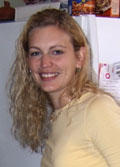
Kristen Kallestad (Thorstenson)
Thesis Title:
Duchenne Muscular Dystrophy and Extraocular Muscle: A potential sparing mechanism with therapeutic implications
Current Position:
Physician, Ridgeview Medical Center and Clinics
Former Position:
Resident, Family Practice, North Memorial Medical Center
Undergraduate Institution and Major/Degree:
College of Saint Catherine, BA, Biology 1999
Major Advisor(s):
Linda McLoon, Ph.D.
Research Description:
The extraocular muscles (EOM) are well characterized as being uniquely spared in Duchenne muscular dystrophy (DMD). Our lab has recently shown intrinsic differences in these muscles compared with limb muscles. Specifically, the muscle progenitor cells, called satellite cells, are activated in the apparent absence of injury. This is unlike the satellite cells of limb muscles, which remain quiescent unless injury is sustained. We have also been able to show that there are a greater number of precursor cells within the EOM than limb.
Our hypothesis is that the EOM are spared from the degenerative effects of Duchenne muscular dystrophy (DMD) due to the presence of higher numbers of a unique precursor cell capable of maintaining a normal phenotype under conditions that normally result in atrophy. I have found a CD34+ group of cells in EOM that is negative for other lineage-specific markers. This population is present in limb muscles of neonatal mice, but is only maintained throughout adulthood in EOM. These cells are also present in the EOM of mdx mice and mdx/utrophin -/- mice, models for DMD. These cells from EOM are more resistant to apoptosis than similar cells from limb muscles. I will perform the following experiments: 1) examine the phenotype and differentiation potential of these cells, 2) determine the mechanism for their resiliency to injury, and 3) examine their ability to repair or regenerate muscle in vivo . Our experiments will use in vitro cell culture including activated caspase and stress-induced death assays. To assess the differentiation capabilities of these cells, we will use flow cytometry to sort the CD34+ population, followed by in vitro differentiation assays using various growth factors and serum deprivation. Ultimately, we hope to transplant our EOM-derived progenitor cells into injured limb muscle of mdx mice in order to determine the regenerative capabilities in vivo . We hope to identify a new source of cells for use in myoblast transfer therapy.
By describing a means for EOM sparing in DMD, we may advance our understanding of the disease and identify a new source of cells for myoblast transfer therapy. These cells, theoretically, would not require transfection of dystrophin, and could potentially provide an autologous source of cells for transplant therapies. This early investigation seeks to better characterize a potentially important cell population which has not been previously described.
Courses Taken Beyond the Core Courses:
- Statistics
- Neurobiology of Disease
Graduate Level Minor:
- Medicine (MD)
Committee Members:
- Daniel Garry
- John Ohlfest
- Deborah Ferrington
- John Day
Selected Publications:
- Kallestad KM, Hebert SL, McDonald AA, Daniel ML, Cu SR, McLoon LK. Sparing of extraocular muscle in aging and muscular dystrophies: a myogenic precursor cell hypothesis.Exp Cell Res. 2011;317(6):873-85.
- Kallestad KM, McLoon LK . Defining the heterogeneity of skeletal muscle-derived side and main population cells isolated immediately ex vivo. J. Cellul. Physiol. 2010;222:676-684.
- McLoon LK, Thorstenson KM, Solomon A, Lewis MP. Myogenic precursor cells in craniofacial muscles. Oral Dis. 2007;13(2):134-40.
Awards and Honors:
- NIH predoctoral fellowship- Translational Research in Neurobiology of Disease 2006-2007
- Marzolf Muscular Dystrophy Training Fellowship, Univ. of Minnesota 2007-2008
Home Town:
- Dhahran, Saudi Arabia
